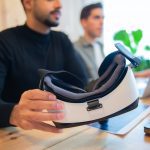Technology drives the world forward. That idea became even more evident as the COVID-19 pandemic presented countless challenges over the past year, and as it continues to do so throughout 2021. With people all over the world staying inside, distancing from one another, and avoiding in-person shopping, industries need ways to bring sales to the consumers. Due to this new … [Read more...] about The Role of AR and VR in Consumerism During the Pandemic
AR / VR
Explore the world of virtual and augmented reality. Discover the latest advancements in VR and AR technology and how they are being used in various industries. Learn how to get started with VR and AR and find resources for further learning.
7 Ways the Oil and Gas Industry Is Making Better Use of Sustainable Technologies
Organizations in the oil and gas supply chain have gone from remarkable success to failure in the past two years. With governments across the Middle East and more extensive world setting targets for lower carbon emissions and the more prominent presence of renewable in their national energy mix. And, the oil and gas industry is looking towards clean tech innovations to find the … [Read more...] about 7 Ways the Oil and Gas Industry Is Making Better Use of Sustainable Technologies
Racing Towards Innovation: How a Battle to Build The Best AR Glasses is Hotting up in The World of Tech
The race to develop the best augmented reality infused glasses may be set to reach fever pitch in 2021 with tech-giants like Apple seemingly set to announce their first entry into the market. But what does the future hold for AR wearables? Ever since the arrival of the iPod, Apple has made gargantuan efforts to position itself at the forefront of innovative technology. So it's … [Read more...] about Racing Towards Innovation: How a Battle to Build The Best AR Glasses is Hotting up in The World of Tech
Virtual Reality: How it Aids the Education Sector
By now, most of the world is well-versed with the concept of mixed reality. However, there has been pronounced interest in virtual reality, which uses technologies to set up a simulated environment. Simply put, virtual reality is an artificially-replicated reality where one can engage and interact with the environment just as they would in real life. Of course, there have been … [Read more...] about Virtual Reality: How it Aids the Education Sector
Enhance Business Productivity through a Digital Platform and Smart Automation
Gone are the days when an enterprise harbored a siloed approach, where different departments worked in four different corners and had their own set of organizational ancestry and lineage. Today, an enterprise, which has true global aspirations, needs to look beyond a siloed work culture. In fact, it has to work together in a wider ecosystem with a self-sustaining target to … [Read more...] about Enhance Business Productivity through a Digital Platform and Smart Automation
What is virtual reality (VR)?
VR is a computer-generated simulation of a three-dimensional environment that can be interacted with in a seemingly real or physical way. VR is typically experienced using a headset and hand controllers, which track the user’s movements and allow them to interact with the virtual environment.
VR can be used for a variety of purposes, such as gaming, training, and entertainment. It has the potential to create immersive and interactive experiences that are not possible in the real world.
What is augmented reality (AR)?
AR is a technology that superimposes digital information or graphics onto the real world, creating a layered experience. AR can be experienced through devices such as smartphones, tablets, or specialized glasses, which use cameras and sensors to track the user’s movements and display the digital content on top of the real world.
AR is used for a variety of applications, including gaming, education, and advertising. It has the potential to enhance the real world with interactive and informative digital content.
What are the differences between VR and AR?
VR creates a fully immersive, computer-generated environment, while AR enhances the real world with digital information. VR requires specialized equipment, such as a headset and hand controllers, to experience, while AR can be accessed through everyday devices such as smartphones.
VR is typically used for fully immersive experiences, while AR is more commonly used for overlaying digital content onto the real world.
What are some examples of VR and AR?
Examples of VR include video games, educational simulations, and virtual tours. Examples of AR include Pokemon Go, Snapchat filters, and interactive museum exhibits. These are just a few examples of the many possible applications of VR and AR, which are being used in a wide range of industries and contexts.
How can I learn more about VR and AR?
There are many resources available for learning about VR and AR on Datafloq, including online courses, books, and industry events. Online courses, such as those offered by Coursera, edX, and Udacity, can provide a comprehensive overview of the technologies and their applications.
There are also many books on VR and AR that cover various aspects of the technologies and their uses. Attending industry events, such as conferences or meetups, can also be a great way to learn about VR and AR and network with others in the field. It is also possible to try out VR and AR experiences at specialized centers or through demos provided by companies that develop VR and AR technology. This can be a great way to get a firsthand experience of what these technologies are capable of.







